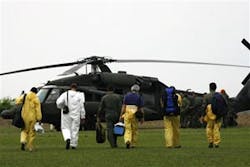Brazil's air force said the cockpit voice and data recorders from an airliner that crashed in the Amazon jungle, killing all 155 people on board, have been found by workers searching the wreckage for bodies.
Gol airlines Flight 1907, a Boeing 737-800, went down Friday after clipping a Brazilian-made Legacy executive jet, and investigators were trying to determine how two new aircraft equipped with the latest anti-collision technology collided in midair.
While the Gol flight slammed into the ground deep in the Amazon rain forest, the damaged Legacy with seven people on board landed safely at a nearby air force base.
Brazilian media reports suggested Monday that a lapse in communication between air traffic controllers in different cities may have led both planes to fly at the same altitude.
The air force said both jets were equipped with a Traffic Collision Avoidance System, or TCAS, which monitors other planes and sets off an alarm if they get too close.
John Hansman, an aeronautics professor at the Massachusetts Institute of Technology, said air traffic in Brazil is complicated in vast regions that are not covered by radar, especially over the ocean and the Amazon jungle.
Pilots often propose a route then along the way check in with controllers who verify the plane's location, altitude and bearing.
"Apparently that process broke down somehow," Hansman said. "When you get to the jungles of Brazil, you have people going in all directions."
As authorities struggled to recover bodies scattered over the jungle floor, Brazil's Air Force said it had recovered the Boeing's voice recorder and the digital flight data recorder.
Brazil's Civil Aviation Agency said the cause of the crash was impossible to say until the recorders were examined.
Investigators will be paying close attention to the conversations between the pilots and air traffic controllers, said Dale Oderman, associate professor of aviation technology at Purdue University, who used to fly in Brazil.
The flight data recorder will tell investigators a great deal about the 737's performance, including altitude and airspeed.
"It might indicate they were flying an altitude they weren't cleared to fly," Oderman said.
The passengers aboard the smaller Legacy, all Americans, included Joe Sharkey, a journalist for The New York Times.
In a story posted on the Times Web site, Sharkey said he felt a terrific jolt and heard a loud bang "followed by an eerie silence, save for the hum of the engines." Part of the Legacy's wing was gone, and its leading edge was losing rivets, and starting to peel back, he said.
"And as our hopes sank with the sun, some of us jotted notes to spouses and loved ones and placed them in our wallets, hoping the notes would later be found," he wrote.
The plane managed to land safely at an air force base.
The larger Boeing, however, crashed near in the remote Amazon near Peixoto de Azevedo in the central state of Mato Grosso, some 1,100 miles northwest of Rio de Janeiro.
The U.S. National Transportation Safety Board said it was sending a team of investigators, who would be joined by representatives from the Federal Aviation Administration and Boeing Co.
The U.S. agencies were involved because the Gol plane was manufactured in the United States and the smaller jet was registered there.
It was the first major disaster for Gol Linhas Aereas Intelligentes SA, Brazil's second-largest airline, which took to the skies in 2001 with six Boeing 737s serving seven domestic destinations.
News stories provided by third parties are not edited by "Site Publication" staff. For suggestions and comments, please click the Contact link at the bottom of this page.






